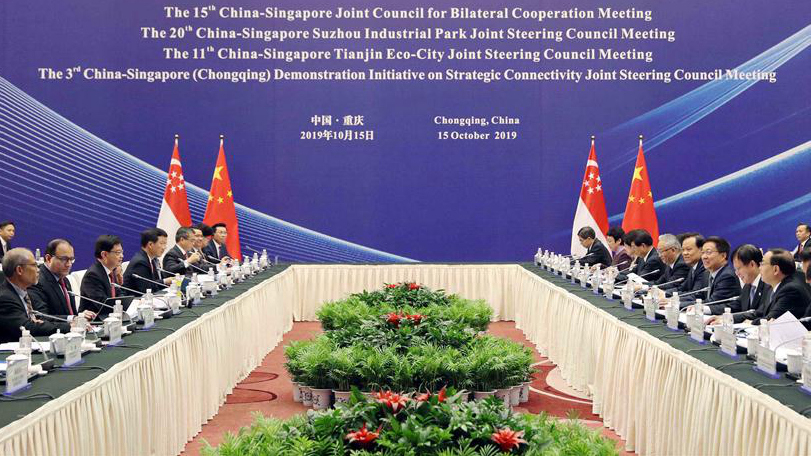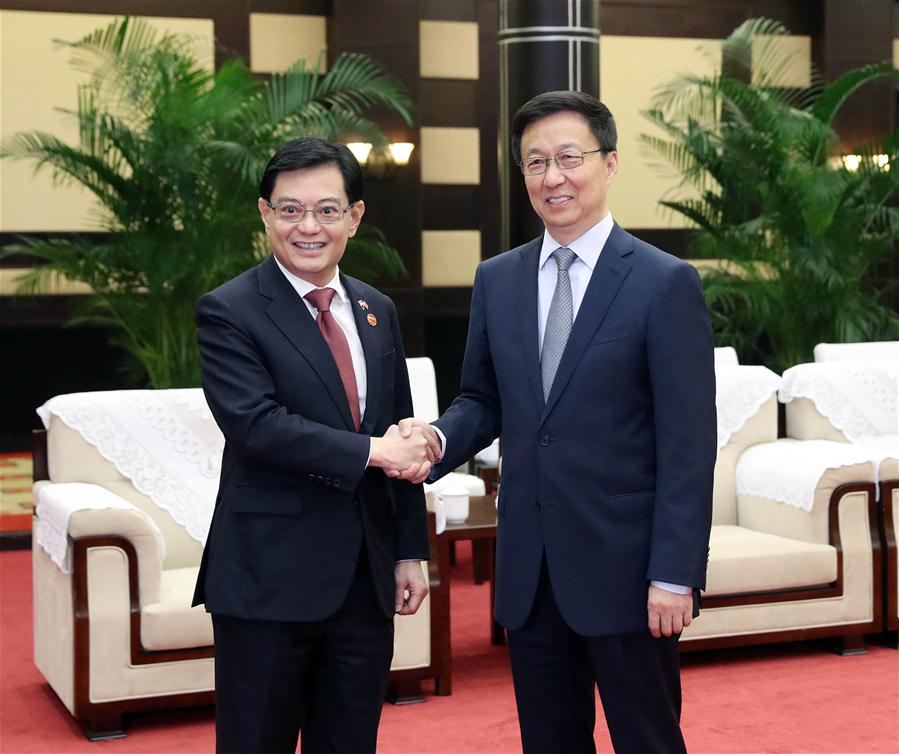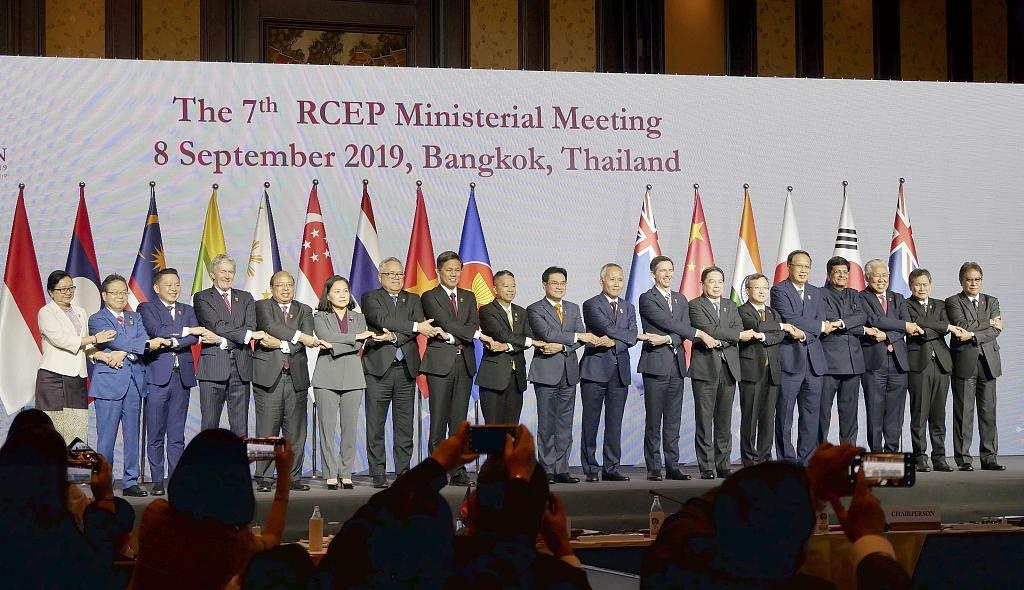
Chinese Vice Premier Han Zheng and Singaporean Deputy Prime Minister Heng Swee Keat co-chair four bilateral cooperation mechanism meetings in Chongqing, China, October 15, 2019. /Xinhua
Chinese Vice Premier Han Zheng and Singaporean Deputy Prime Minister Heng Swee Keat co-chair four bilateral cooperation mechanism meetings in Chongqing, China, October 15, 2019. /Xinhua
Editor's note: Ji Xianbai is a research fellow with the International Political Economy Program at the S. Rajaratnam School of International Studies, Nanyang Technological University, Singapore. The article reflects the author's opinions and not necessarily the views of CGTN.
The Protocol to Upgrade to China-Singapore Free Trade Agreement (CSFTA) takes effect on October 16. It was announced at a top-level meeting of 15th China-Singapore Joint Council for Bilateral Cooperation co-chaired by Chinese Vice Premier Han Zheng and Heng Swee Keat, Singapore's deputy prime minister.
The original CSFTA was in force from 2009, and the two countries started to negotiate for an upgrade in 2015. After eight rounds of talks and three years, the two sides inked a modernized trade agreement in November 2018 in Singapore. It was witnessed by Premier Li Keqiang and Prime Minister Lee Hsien Loong.
Because the original agreement had already eliminated almost all tariffs restricting bilateral merchandise trade flows, the upgraded version of the agreement mainly improves on reducing non-tariff barriers to trade, services and investment.

Chinese Vice Premier Han Zheng (R) meets with Singaporean Deputy Prime Minister Heng Swee Keat, Chongqing, China, October 15, 2019. /Xinhua
Chinese Vice Premier Han Zheng (R) meets with Singaporean Deputy Prime Minister Heng Swee Keat, Chongqing, China, October 15, 2019. /Xinhua
For example, China and Singapore agree to establish a more robust Investor-State Dispute Settlement and simplified customs procedures that go beyond the two countries' respective investment protection and trade facilitation obligations under the prevailing multilateral rules.
China pledges to liberalize its petrochemical, legal, maritime and construction service sectors for Singaporean companies in exchange for greater access to the city-state's skilled labor market and banking industry. Also, three completely new chapters on competition, environment and e-commerce have been added to the original agreement, reflecting the need for regulating 21st-century international trade.
The enactment of the upgraded and expanded CSFTA is timely for both China and Singapore. For China, the agreement signals Beijing's continual commitment to carrying through economic reform and opening-up at home while promoting a rules-based, win-win economic partnership abroad.
For Singapore, the trade pact is poised to re-energize its lackluster economic outlook this year. The latest forecast suggests that Singapore's economic growth in 2019 would be around 0.6 percent. If that projected figure comes out true, it will be the worst annual economic performance for Singapore since the global financial crisis.
Singapore hopes that the new CSFTA will create enormous trading opportunities in China, its largest trading partner, to offset the negative effects of U.S.-China trade confrontation.
As the new CSFTA goes into effect, China and Singapore need to join forces to get ongoing talks on a 16-party Regional Comprehensive Economic Partnership (RCEP) over the line for a successful conclusion, at least at a technical or political level, in 2019.
On October 12, Bangkok hosted another Intersessional RCEP Ministerial Meeting. While RCEP nations clearly made some headway in landing agreement on eight (unspecified) chapters, ministers failed to issue a joint statement largely because of some specific demands raised by India.

Participants of the RCEP Ministerial Meeting join hands in Bangkok, Thailand, September 8, 2019. /VCG Photo
Participants of the RCEP Ministerial Meeting join hands in Bangkok, Thailand, September 8, 2019. /VCG Photo
In Bangkok, India asked for five more years to cut tariffs, the right to localize data and impose taxes on electronically transmitted goods under the e-commerce chapter, and the ability to self-initiate RCEP-wide safeguard procedures in the face of a sudden surge in imports. India failed to win over support from skeptical RCEP partners, including China, Japan, New Zealand and Australia, in Bangkok.
Should New Delhi fail to get its way on those issues soon, it is likely that there will not be an RCEP deal to be put to leaders at the 35th ASEAN Summit and Related Summit in early November. There is also the possibility that RCEP will go ahead without the full participation of India.
During the September negotiations, Association of Southeast Asian Nations (ASEAN) countries asked India to clarify its position, and some really frustrated and pro-trade countries like Singapore have reportedly told India to seriously consider if it really wants to stay in the trade pact.
India's Prime Minister Modi will have a tough decision to make about India's membership in RCEP. The upgraded CSFTA should serve as an aspiration. When there is a global tide in favor of protectionism, China and Singapore, through pulling off an upgraded CSFTA, say "yes" to free trade, economic cooperation and shared prosperity.
But throughout the years by slowing down RCEP progress, India has been saying "no" to what would be the world's largest and most populous regional trade agreement. As the RCEP summit date draws nearer, it is time for India to finally say "yes" to RCEP.
(If you want to contribute and have specific expertise, please contact us at opinions@cgtn.com.)